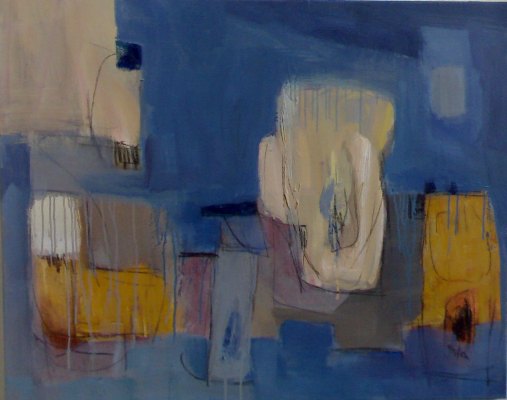Artists

Delft-Rebel, Gerdien van - VM - Cisca Ireland
Gerdien van Delft-Rebel: The Night Watchman

Hope in the Darkness
by Cisca Ireland-Verwoerd
This painting, called The Night Watchman, is executed in acrylic paint and crayon on a canvas of 40x32 inches (100x80 cm). We see a number of organic, square-like and rectangular shapes. The shapes are dark goldenrod, grey, light blue, pinkish and whitish. Most of the blocks form a wobbly horizontal band. The third shape from the right looks as if it overlaps several others, which gives the illusion of being closer to us than the others. A white/grey square with two small black squares draws our eyes toward the upper left corner of the painting. Most of the shapes have a partial outline in black crayon, as well as some free form lines within. The oblongs hang suspended in a blue background of different hues. Drips of blue paint come down over several of the colored segments.
Gerdien van Delft-Rebel (b. 1978) says of this image that we can imagine the walls of Jerusalem/Zion over which God’s light shines by way of an angel who watches over the city. This represents a promise, she continues, that also applies to our life. It is just as Psalm 121 says: ‘The Lord will keep watch over your coming and going’ (vs. 8).
It is impossible to talk about a Dutch painting called The Night Watchman, without thinking of the most famous of Dutch paintings: Rembrandt’s Night Watch. At first glance the small, abstract contemporary painting of Van Delft-Rebel has nothing in common with the enormous (143x172 inches; 363x437 cm) 17th-century militia painting. But when we look at the Night Watch with some distance, it too has a wobbly horizontal band, formed by the militia men with their characteristic long-barreled guns. In the middle (but in the original size more to the right) the bright colored figure of Willem van Ruytenburg, lieutenant to Captain Frans Banning Cocq in the middle, jumps out at us – just like Van Delft-Rebel’s white/grey oblong. The Night Watch too has a movement upwards on the left side, because of the yellow and blue striped company banner proudly held high by ensign Jan Visscher Cornelissen. Rembrandt’s painting celebrates the guild of armed, leading citizens of Amsterdam, responsible for keeping the peace at night. In all their human glory, however, they cannot compete with Van Delft-Rebel’s night guard: the Lord himself, who watches over you, who will keep you from all harm – both now and forever (Ps. 121: 5; 7-8).
We see Van Delft-Rebel’s shapes in muted colors. The dark is not pitch black – it is the time when night is about to become day. It is as if the night dissolves in tears of blue. Yet the weeping which may hang around for the night, turns into joy in the morning (Ps. 30:6). This is the time of night when, finally, all our waiting is paying off: ‘My soul waits for the Lord more than watchmen wait for the morning’ (Ps. 130:6). The break of day is the moment we wait for when we are in the darkness of the valley of the shadow of death, or in the dark night of the soul. And yet, even when the promise of the coming morning still lacks fulfillment, the Lord is our light in the darkness: ‘Where can I flee from your presence? Even the darkness will not be dark to you, the night will shine like the day, for darkness is as light to you’ (Ps. 139:7,12). The foundation of our hope is not in the coming of the morning, in changes of circumstances. Our hope is in the presence of God himself in the midst of our darkness: Emmanuel – the Light has come.
*******
Gerdien van Delft-Rebel: The Night Watchman, 2008, acrylic paint and crayon on a canvas of 40x32 inches.
Gerdien van Delft-Rebel is a Dutch illustrator and graphic designer who also paints. She considers herself an image maker rather than an artist. Van Delft-Rebel simply wants to offer images that will, she hopes, challenge people to think about the world beyond the image, and maybe even about God. Everyone who looks at her images is invited to bring their own ideas and imagination to the visual presentation expressed by Gerdien. www.studiorebel.nl/?language=UK. On Facebook: https://www.facebook.com/studiorebel
Cisca Ireland-Verwoerd resides in Boston, MA, with her husband and son. She lectures and writes about her two favorite topics: mission and theology in art.
ArtWay Visual Meditation January 9, 2011






